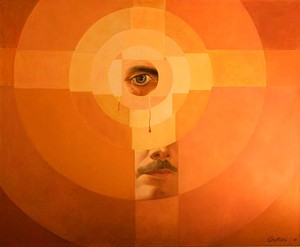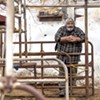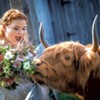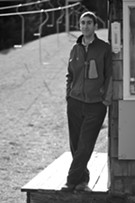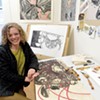Published September 9, 2009 at 6:27 a.m.
Imagine how it might feel to write a novel — only to discover, just before sending it off to the publisher, that someone in your town had made a surreal film that seemed to illustrate all the ideas you’d put in your book. Would you be shocked? Mystified? Elated to find a creative soulmate?
Dr. Albert J. Levis, a psychiatrist who lives in Manchester, probably experienced all those emotions and more when he first met the artist Henry Gorski in 1972. The brainchild of their friendship is a synthesis of art and science — a scientific interpretation of art, and an artistic representation of science — that is displayed at the Chaffee Art Center through October 12.
The exhibit, “Science Stealing the Fire of the Gods and Healing the World,” uses what Levis called his “Formal Theory of Behavior” to interpret Gorski’s abstract and symbolic oeuvre of oil paintings, bas-reliefs, mixed-media works and sculptures. “He was looking for the mathematical proof of the metaphysical existence of God,” says Levis of Gorski. “I was able to show him it was in his art.”
The name of the exhibit comes from the Greek myth of Prometheus, who stole fire from Zeus and gave it to mortals. Here, the forbidden “fire of the gods” appears to be knowledge of human nature, which Levis’ scientific theory draws from art and translates into a moral framework through which to interpret behavior.
Gorski, 91, was born in Lackawanna, New York. His first artworks were sketches of men drinking beer at his father’s tavern. He went on to get a bachelor’s of fine arts at the University of Buffalo and then served in the United States military during World War II, making models of islands that would later be bombed. The art on display at the Chaffee — all of which is owned by Levis and permanently displayed at his bed and breakfast in Manchester, the Wilburton Inn — was created between the early 1960s and 1990s. For Gorski, this was a period of intense reflection — about his two sons, the Vietnam War, religion and morality.
Levis, 71, is a Greek-born Jew who lost his father and grandfather in World War II. By the end of that conflict, 96 percent of his Greek-Jewish community had been killed; thousands more Greeks, including some of his friends, died in the ensuing civil war, which Levis witnessed. “I grew up wondering, Why is the world so crazy?” he recalls.
Levis went to medical school in Geneva and Zürich, moved to the U.S. in 1964, and finished his psychiatric training at Yale in 1967. Shortly thereafter, he opened a psychiatric practice, the Center for the Study of Normative Behavior, in Hamden, Connecticut.
It was there that Levis began his research into the nature of human conflicts and their resolutions. He detected a pattern of behavior that starts with an initial stressor and ends with a compromise. Drawing it on paper, he noticed the pattern resembled a wave or a pendulum that swings but tends toward rest — the equivalent of the physical principle of simple harmonic motion. Levis’ Formal Theory of Behavior asserts that, unconsciously, we are all moving along this wave, oscillating from stress to response to anxiety to defense to reversal to compromise, and then starting all over again. He calls this the Conflict Resolution Process and contends that the pattern also governs artistic creation and is reflected in works of visual art, literature and mythology.
Preparing to present his theory to the New Haven Medical Association in 1972, Levis sought a visual aid that would make it all less abstract. Someone suggested he visit Gorski’s studio, also in Hamden.
When the men met, they both realized there was “a natural gravitation,” as Gorski put it in a 1987 letter to Levis, between their art and science. “Albert Levis,” Gorski wrote, “perceived seemingly parallel directions in my paintings as symbols applicable to his Formal Theory of human behavior — directions of which I was not consciously aware.”
The retrospective at the Chaffee uses the Formal Theory of Behavior to organize Gorski’s work, separating it into three “acts” like those of a drama, each composed of about eight paintings. The acts represent phases of Gorski’s life, and the artwork seems to be his way of grappling with the challenges that faced him in each.
The first act, for example, entitled “Pain Things,” revolves around Gorski’s autistic son, whose disability was so severe that he was eventually institutionalized. It begins in Levis’ “stress” phase with “Child of Darkness,” a dark impression of a boy’s face obscured by shadow, his closed mouth highlighted. The “response” phase is embodied by “Consumer Consumed … Consumed,” a series of open mouths enclosing each other, all screaming in anger and frustration. The next phase is “anxiety,” represented by the painting “Odysseus,” in which Gorski depicts a crazed man grasping a steering wheel through cell bars. “Odysseus is blocked and blind,” explains Levis in an interview. “He doesn’t see where he’s going.”
The reaction to anxiety is “defense.” In “Walls of Fear,” walls at right angles block the mouths of bald heads pictured at the bottom right and bottom left. The center of the painting depicts a small window leading to an open mouth with a trace of a smile. “Our fear of emotions,” Gorski wrote about this work, “our habit of treating normal feelings as deplorably sentimental, and strong emotions as simply hysterical or funny, betrays our fundamental fear of life.”
The next swing of the pendulum brings Gorski to what Levis calls “reversal,” a passive phase of feeling helpless. “The Dream” shows a robot-like head with its mouth agape but barred by transistors and wires. “This is the human predicament in our age,” says Levis, “when you feel all the gadgetry and instruments becoming you.”
The final stage of the dialectic is compromise. Gorski depicts this resolution with a figure emerging from an abstraction. The first act ends with “Birth of Adam,” in which a white head seems to materialize from a thumbprint. “A head is rising from the cocoon of amniotic fluid,” Gorski wrote. “For man, birth is the start of pain, conflict and repression.” Perhaps Gorski is here evoking the essentiality of compromise, suggesting that life is not full of winners and losers, but survivors.
Gorski was raised a Catholic, and Christian symbolism figures prominently in his work. When his “compromise” paintings don’t depict human heads, they usually incorporate a crucifix into a face. Levis interprets this as meaning that, while Gorski is tempted by things like infidelity, he ultimately defers to the moral standards of his religion. He accepts the limits Catholicism places on him and reforms his behavior accordingly.
To highlight this aspect of Gorski’s thinking, Levis included in the exhibit some paintings by Gorski’s contemporary, Francis Bacon, whom he describes as just the opposite. “Bacon is an aggressive thinker,” says Levis. “He challenges the acceptability of homophobia, challenges religion.”
Levis sees faith as important to the Formal Theory of Behavior because religions have, for so long, caused conflicts by dictating accepted forms of behavior. But they also offer paths to compromise. Unlike Gorski’s art, with its Christian focus, the Conflict Resolution Process blends paradigms of resolution from Greek, Asian and Judaic traditions.
On September 11, when the exhibit opens, the dangers of “holy war” are sure to be on people’s minds. That’s no coincidence, says Levis. He believes his theory “explains how we can get out of this war, conceptually.” Whether Levis’ notions about conflict are truly “fire from the gods” or just common sense, their pairing with Gorski’s art is inspired.
Want to see more?
“Stealing the Fire of the Gods,” a Henry Gorski retrospective, is on view at the Chaffee Art Center, Rutland, September 11 through October 12. Opening reception is Friday, September 11, 5-8 p.m. Info, 775-0356.
More By This Author
Speaking of Art, eyewitness
-

Q&A: Catching Up With the Champlain Valley Quilt Guild
Apr 10, 2024 -

Video: The Champlain Valley Quilt Guild Prepares for Its Biennial Quilt Show
Apr 4, 2024 -

Q&A: Meet a Family in Waterbury That Embraces Halloween Year-Round
Feb 14, 2024 -

Video: Goth Family in Waterbury: Sarah, Jay and Zarek Vogelsang-Card
Feb 8, 2024 -

Q&A: Art Entrepreneurs Tessa and Torrey Valyou Celebrate 15 Years of New Duds
Oct 11, 2023 - More »
Comments
Comments are closed.
From 2014-2020, Seven Days allowed readers to comment on all stories posted on our website. While we've appreciated the suggestions and insights, right now Seven Days is prioritizing our core mission — producing high-quality, responsible local journalism — over moderating online debates between readers.
To criticize, correct or praise our reporting, please send us a letter to the editor or send us a tip. We’ll check it out and report the results.
Online comments may return when we have better tech tools for managing them. Thanks for reading.


































